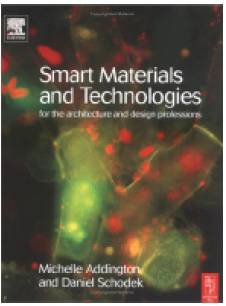This book is about the classification of Materials in Architecture. Starting from the earlier 19th century, when all the structures were roughly built; the workers were unaware of the material strength. The scenario changed with The Industrial Revolution. And with the invention of Steel.
In 1931 when Aerogel was invented the phenomological understanding of the masses changed slowly. It was just 3 times heavier than air and supported heavy loads.
As the definition says, Smart Materials are materials that can remember configurations and can conform to them when given a specific stimulus. But, when we talk about the Molecular level it should have four main characteristics :
* Immediacy – They respond in real time.
* Transiency – They should respond to more than one environmental state.
* Self-Actuation – Intelligence is internal rather than exterior to the material.
* Directness – The response is local to the activating event.
Objectives of the Book are thus three fold:
- First: to provide a primer on Smart Materials. A basic language of materials that architects and designers can understand.
- Second objective is the framing of these materials and technologies as behaviors or actions and not simply as artifacts.
- Third objective is the development of a methodological approach for working with these materials.
Fundamental characterization of Materials :
Matter and Material- the interior forces which makes a material.
Bonding forces between atoms makes them to create a material in different ways.
In Fundamental Differentiation, it talks about the differentiation of matter in form of its bonding, i.e. Ionic, covalent or metal (van der wall’s) bonds.
In Engineering classification we classify them on the basis of their availability. There are around 300000 materials readily available to the engineers and steel alone have its 2000 varieties in them.
In traditional classification they are classified on the basis of their usage throughout the ages.
ENERGY : BEHAVIOR, PHENOMENON AND ENVIORNMENTS
Fundamentals of energy classify energy as potential and kinetic energy.
Work energy, Electric energy , Elastic energy, Chemical energy, Nuclear and Magnetic energy.
And the main thing of consideration here is that the building is affected by all of these.
Laws of Thermodynamics that are applicable on a building are :
First Law- Energy of the system is equal to the loss in energy of the surroundings.
Second Law- State of the object or Material system X property = function of energy transfer.
Conduction is the mode by which heat is transferred through a solid body or through a fluid at rest.
Convection is the mode by which heat is transferred as a consequence of the motion of a fluid.
Radiation is the mode by which heat is transferred by electromagnetic waves, thereby not requiring a medium for transport; indeed thermal radiation can take place in a vacuum.
Types and characteristics of smart Materials :
Property change capability : This is the capability of changing in accordance to the conditions.
Energy exchange capability : It follows the first law of thermodynamics.
Discrete size/location .
Reversibility.
Elements and Control Systems :
Sensors, detectors, transducers and actuators.
Control System ( Logic controllers )
MEMS ( Micro-electrical mechanical systems ) Sensor Networks
Input / Output models.
SMART COMPONENTS :
- Façade Systems : Façade systems, and particularly glazing, pose an intractable problem for designers. The façade is always bi-directional in that energy transfers in both directions simultaneously.
- Lighting Systems : The production of artificial (electrical) light is the most inefficient process in a building. As such, there has been a concerted effort to improve the efficiency of the individual lamps.
- Energy Systems : There are three types of energy needs in a building: thermal, mechanical and electrical. Thermal energy is necessary for heating and cooling of spaces, refrigeration, water heating and cooking. Mechanical energy is necessary for fans, motors, compressors, pumps and many appliances. Electrical energy is only directly required for lighting and peripheral equipment such as televisions and computers.
- Structural Systems : Structures behave in complex ways when subjected to forces that originate externally to the structure (winds, earthquakes) or are due to its use context, or even its own dead weight. Specific members, for example, bend or tend to buckle. ( Piezoelectric )
This book review was written by: Amit Singh Rothan


Leave a Reply
You must be logged in to post a comment.